
|
Last November I had the opportunity to travel during a week-long break in our London term and visit my good friend Ken Hemba in Milan, Italy where he had been spending his term abroad. During the course of the week I visited four different cities--Milan, Venice, Florence and Rome. On Saturday the eighth I arrived in Milan where I was greeted by Ken at the airport. Ken had warned me before I came that Milan is not a particularly touristy place. I found that what he said was very true--Milan is not really a tourist's paradise by any means. That being said, it was probably the most candid view of actual Italian city life I got that week. Unlike Venice, Florence, or Rome where you're as likely to be greeted in English at shops and restaurants, Milan is full of real honest-to-god Italians, speaking Italian, and working and living in a manner not in the least affected by a need to pander to tourists. And there's something to be said about that. Due to some unfortunate camera problems, my time in Milan is completely without photographic record. I would have very much liked to take some pictures of the striking Galleria, a glass covered shopping center, along with the cities castle and the duomo. (Duomo is the Italian word word for cathedral. Milan's duomo is well known for its distinctive and striking architecture--which made it all the more unfortunate that the front facade was covered in scaffolding. But, hey, preservation's a good thing.) While I resisted any urge to enter any of Milan's famous fashion stores, it was hard to ignore the fact that the city provided many venues where a shopper could easily spend thousands of Euros on one item of clothing. (I also noticed that there was an Emporio Armani aircraft hangar at the Milan Linate airport... Perhaps Armani sells designer planes?) I spent Sunday in Milan with Ken seeing the various sites. It really is a fascinating city, if not the most picturesque. Because Milan has a fairly limited number of attractions many of them are in high demand--to see Leonardo da Vinci's 'Last Supper', located in a seemingly unremarkable church slightly outside the center of the city, requires advanced booking to get a 15 minutes viewing time slot. It was sold out for all the time I was in Milan so I didn't get to see it. On Monday I took a high speed Eurostar train to Venice by myself while Ken attended classes back in Milan. (Happily, I was able to find a camera store that sold the exotic batteries required to revive my camera.) I had heard that Venice was an island (or, more accurately, a large number of islands) but I wasn't really prepared for how dramatic an entrance the city made. Venice proper is connected to mainland by a two mile long causeway wide enough for a couple lanes of traffic and two sets of train tracks. As you approach you can see the city and its numerous towers and domes rise out of horizon in front of you--it's really a remarkable sight to behold. 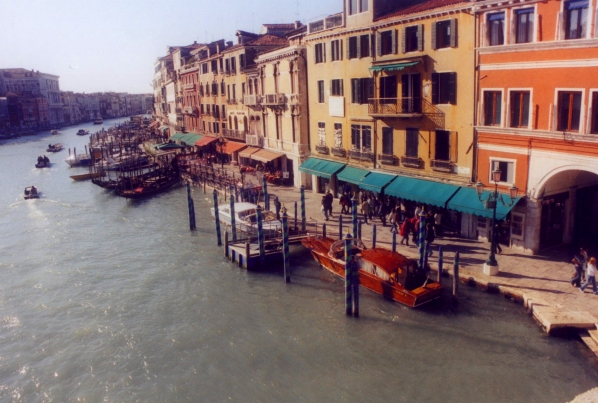 Speed boats and gondolas parked along the Grand Canal. Walking out the front doors of Venice's train station brings you face to face with the Grand Canal. Water based public transport--water busses, water taxis, gondolas--abound, but prices can be prohibitive. Gondolas apparently run for around $80 an hour--much more if you require a tenor or accordion player. At that price it shouldn't be surprising that the only gondola riding Italians I saw were the gondoliers. (I did note, however, that there seemed to be a surprisingly large number of middle-aged Japanese men in suits riding gondolas everywhere one looked... not exactly the same gondola-riding public shown in all the movies.) I had been told by several acquaintances not to have high expectations of Venice--they made it out to be a tourist trap unpleasantly crossed by rank canals that smelled of sewage. I didn't have this experience at all and I think it was largely due to visiting during the off-season. The place was comfortably bustling on a November Monday and I can only imagine that high summer crowds and high summer heat could quickly make the city considerably less charming. To add my own personal contribution to a festering cliché, Venice does, in a way, come off as a "timeless" place. Sort of. Largely, I think the impression of being removed from modern life is created by the complete absence of cars in the bulk of the city. And unlike most places, there is really only a negligible amount of modern construction--almost everything is old. (The train station, which easily dates back half a century, seemed like an obscene inclusion among the renaissance churches of the Grand Canal.) All this noted, the placed isn't an untouched fantasy land. I couldn't help but notice as I walked over one of the countless bridges that gondola-riding couple passing underneath were being serenaded not by the music of, say, Puccini or Verdi but by a tenor's awkward rendition of Andrea Bocelli's public-television fueled hit Time to Say Good bye. A timeless selection, indeed. (Though it is an unquestionably more appropriate choice than, say, Britiney Spear's Slave for You.) 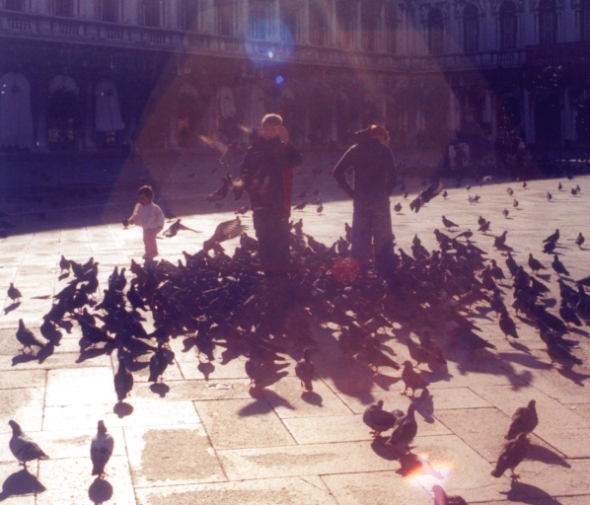 Pigeons and tourists try to remember exactly how this peculiar symbiotic relationship began. St. Mark's Square (Piazza San Marco) is at the heart of Venice and I was lucky enough to visit on a day when it wasn't submerged under several inches of water. (Among Venice's problems is the itsy-bitsy issue that it's slowly sinking into the ocean. Or maybe the water levels going up. Either way, really.) As I had a nice dry day I got to witness first hand people paying money (only one Euro!) to have pigeon food (and thus pigeons) placed all over their bodies. Don't get me wrong. I have nothing against feeding and/or celebrating pigeons--I'm thoroughly against the Mayor of London employing hawks to rid Trafalgar Square of our beloved winged rodents--but I don't generally feel the need to cover my hands, shoulders, and head with them. Maybe I'm just wierd like that. I witnessed several people dish out money just to decide that having dozens of pigeons perched on all horizontal surfaces of your body wasn't nearly as fun as it looks (Gee, really?) and promptly start shaking in a manner reminiscent of something between an epileptic seizure and dancing the Macarena in a (largely unsuccessful) bid to rid themselves of the well fed birds. Standing at the end of St. Mark's Square is the church that gives the place its name (Basilica di San Marco), along with the former palace of the city's ruler (Palazzo Ducale). The Basilica is a truly fantastic place--it is easily the most unique church I've been to in all of Europe. While it's certainly not a small church, it's not size that makes it notable. (Interestingly, though the church is located on a prime bit of public space, it was never a church for the greater public--it was originally used as the private church for the city's ruling duke.) The remarkable thing about the place is it's combination of eastern and western influences; architecturally speaking, there's clearly more in common here with Constantinople than Rome. The church, with all of it's bright colored mosaics and precious altar pieces, has a wholly sacred and other worldly air to it that is lacking from most famous (and, as such, tourist-covered) churches and cathedrals I've visited. I can only imagine what effect the place would have had back in the days when it was lit with candles rather than halogen lights--it must have been enchanting. 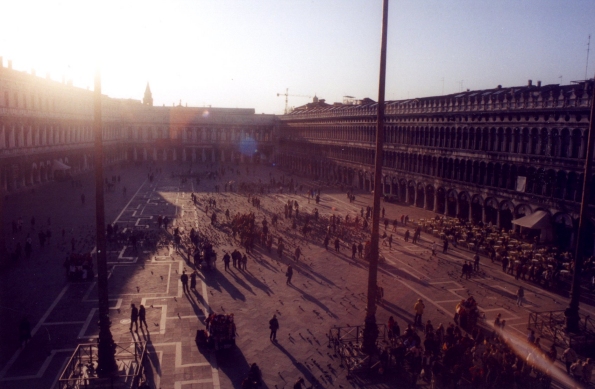 Piazza di San Marco seen from the roof of the basilica. All told, Venice really is an incredible place and I wish I had more than a day to spend there. There is something very special about a great island city full of five hundred year old buildings and crossed by hundreds of canals--it's sad to hear that the actual population of the city has being going down for decades. |
Part 1 - Milan and Venice Part 2 - Florence and Rome 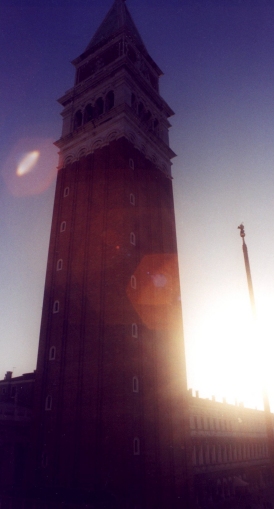 The Campanile in Saint Mark's Square, Venice. 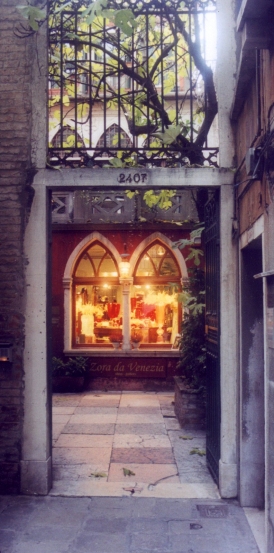 A shop brightly shop in a back street of Venice. 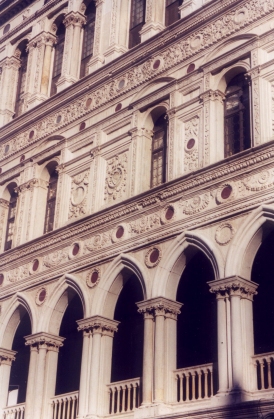 The courtyard facade of the Ducal Palace. 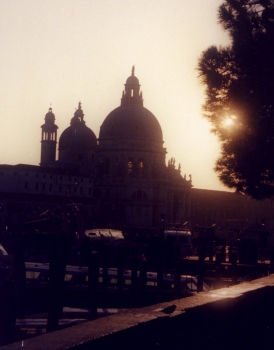 One of Venice's many monumental churches. |